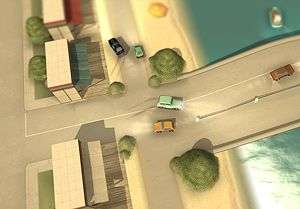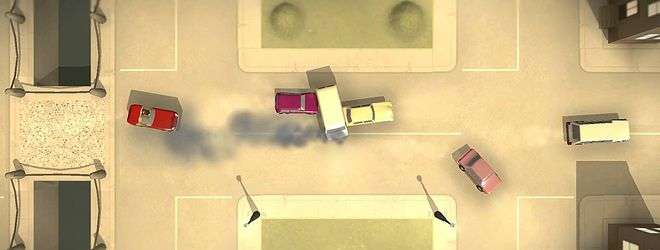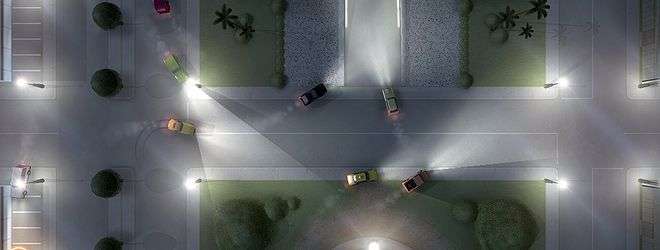Does Not Commute – Review
by Mark R
| Title | Does Not Commute | |
| Developer | Mediocre AB | |
| Publisher | Mediocre AB | |
| Platform | iOS, Android | |
| Genre | Strategy, Driving | |
| Release Date | April 23, 2015 | |
| Official Site | http://www.mediocre.se/commute/ |
 Close your eyes and picture the scene: it’s 1979 and a dark-green ridge tent has been set up in the garden, with three boys between the ages of seven and eight huddled around something magical, begging to be the next person to steal a few minutes with Richard’s incredible birthday present. The technological marvel was Tomy’s Demon Driver – a large, clunky piece of plastic with a steering wheel which controlled a barely visible racing car printed on to a stiff clear-plastic tab. The display also showed three very important elements – a lane marker, as well as the left and right traffic lanes, all of which were printed on to loops of acetate. The central lane marker would move at the same speed while the left and right lanes would vary in speed so that the printed traffic would randomly travel towards you. If you hit one of the oncoming vehicles, a red LED would illuminate a clear plastic ‘crash’ symbol. How times have changed.
Close your eyes and picture the scene: it’s 1979 and a dark-green ridge tent has been set up in the garden, with three boys between the ages of seven and eight huddled around something magical, begging to be the next person to steal a few minutes with Richard’s incredible birthday present. The technological marvel was Tomy’s Demon Driver – a large, clunky piece of plastic with a steering wheel which controlled a barely visible racing car printed on to a stiff clear-plastic tab. The display also showed three very important elements – a lane marker, as well as the left and right traffic lanes, all of which were printed on to loops of acetate. The central lane marker would move at the same speed while the left and right lanes would vary in speed so that the printed traffic would randomly travel towards you. If you hit one of the oncoming vehicles, a red LED would illuminate a clear plastic ‘crash’ symbol. How times have changed.
With so many modern vehicle-based games focusing around being the first to cross the finish line, or achieving the fastest time, it’s a refreshing change to see that someone has taken steps to think outside of the box. Developed by the inappropriately named Mediocre, Does Not Commute is unlike any other driving game in that an entire level may take you fifteen minutes to complete, yet you never leave the same sixty-second time period. You are essentially trapped in a Groundhog Day-style time loop until such times as you complete your tasks and can move on to the next area. Confused? You won’t be.
Your game begins by focusing on a single vehicle within an overhead view of a town, explaining why this particular person is on the road and what their goal is. Their destination is marked by a series of flashing cyan chevrons and your task is to get them to their destination as quickly and safely as possible. Doing so involves controlling their vehicle by simply touching either the right or left hand side of the screen long enough for their perpetually moving vehicle to turn in that direction. Some directions take getting used to as it’s all from the imaginary perspective of the driver themselves, so if they are coming from the top to the bottom then touching the left of the screen will have the driver turn to the right.
 It all sounds simple enough, and it is. The first driver will undoubtedly reach their intended destination in a relatively quick time, and without incident. The second driver, however, then appears on the same overhead view and is taken back to the same point at which the first began their journey… your original journey. Every twitch and turn you performed with your previous driver is played out automatically as every new driver is introduced so that each becomes an obstacle for the next. While you may have thought it was smart to cut between buildings to get from the starting point to the destination for Mrs Brown, you may find that their vehicle now blocks an important through-route for Dr McLeod which will then force you to take the long way round, and this could be your downfall.
It all sounds simple enough, and it is. The first driver will undoubtedly reach their intended destination in a relatively quick time, and without incident. The second driver, however, then appears on the same overhead view and is taken back to the same point at which the first began their journey… your original journey. Every twitch and turn you performed with your previous driver is played out automatically as every new driver is introduced so that each becomes an obstacle for the next. While you may have thought it was smart to cut between buildings to get from the starting point to the destination for Mrs Brown, you may find that their vehicle now blocks an important through-route for Dr McLeod which will then force you to take the long way round, and this could be your downfall.
Timing is everything, and strategising in advance as well as on-the-fly is the key to success for Does Not Commute. However many seconds you have left when you reach your destination is how much time you then have for the next driver to achieve their goal, and any collisions – whether they’re with other drivers, buildings, or environmental obstacles – will immediately slow you down considerably. Thankfully, as each time period resets for the next driver, markers for extra-time pickups are shown. If you can get to them without putting yourself at risk these will extend the time for your current driver, as well all subsequent vehicles. Assuming you can reach them without running in to one of your previous runs.
Over time, special abilities are unlocked which offer both an advantage and a handicap, and these are selected before you set off with each new driver. Selecting the turbo option will result in a much faster vehicle, but the road handling will be compromised. On the flip-side, you can opt for better traction and have to suffer a much slower speed – this can be incredibly frustrating if the vehicle ends up being slow by default, but you don’t know how any will handle or perform until you set out. If you want to plough through the opposition, you have the option to select armour but, once again, this comes at the detriment of speed.
By the time you reach the fifteenth driver within a particular area, avoiding all of your previous journeys becomes a question of clever forward-planning and selecting the best boost to achieve this. If you opt for the free version of Does Not Commute and completely screw up any of your areas by not getting the final driver to their destination, you are thrown back to the start of the game as there’s no checkpointing. This can be particularly frustrating if you’d managed to clear the first few areas and were suddenly thrust back to play through each of them again. Thankfully, the only in-app purchase with Does Not Commute is to enable checkpointing so that every cleared stage is stored. Failure will still result in going back to the start of that level, but at least those completed beforehand remain intact.
 If you completely screw up an attempt with one particular vehicle, you have the option to rewind the scenario to the start of the timer and give that driver another go, but you’ll incur a one-second penalty from your time. This can be entirely inconsequential at certain points where you may have thirty or forty seconds on the clock and a number of time pick-ups on the map, but in other scenarios you may have only ten seconds and know that the only way to get through this is to pick up a time boost, but existing traffic is making it difficult to collect it. So if you crash and rewind you now only have nine seconds to get to the boost… and it’s often the case that even one second will be the difference between a pass and a fail.
If you completely screw up an attempt with one particular vehicle, you have the option to rewind the scenario to the start of the timer and give that driver another go, but you’ll incur a one-second penalty from your time. This can be entirely inconsequential at certain points where you may have thirty or forty seconds on the clock and a number of time pick-ups on the map, but in other scenarios you may have only ten seconds and know that the only way to get through this is to pick up a time boost, but existing traffic is making it difficult to collect it. So if you crash and rewind you now only have nine seconds to get to the boost… and it’s often the case that even one second will be the difference between a pass and a fail.
Mediocre have clearly thought well outside the box for the gameplay, and it will invariably involve replaying certain levels at least once through to allow you to pass to the next area. As the on-screen obstacles are created by the player as they control each of the vehicles, no two attempts will be the same, and so it’s impossible to cheat the system by remembering where anything is or where something spawns. In fact, even the tiniest delay in switching direction can mean that what was once a clear path on your previous attempt will now have a hulking great truck in your way when you’re trying to get a speeding police car to their destination.
That’s pretty much where the replay value ends, sadly. As gloriously frustrating as it is to run out of time only a few metres from the destination point of the final car within an area, the only reason to play through that level again is to allow passage to the next. Once you clear each area and reach the end of the game, it’s doubtful that you’ll have had enough of a thrill to go back through and play over. Perhaps that’s just a personal opinion, but with no in-game challenges or high-score tables there’s no real pull when it comes to that ‘one more try’ factor. It’s engaging enough at the time, and certainly makes for a great – if frustrating – few hours, but once it’s over, it’s over. For a measly £1.60, however, it’s well worth the money.
Pros- Very different take on the driving genre
- Performs well and looks great
- The Groundhog Day effect is a genius move
- Excellent value for money
- You're effectively playing against yourself fifteen times over in each level
- Having no tutorial made it difficult to understand the controls which, typically, ended up being ridiculously simple
- Not much replay value
Mediocre have done something with Does Not Commute which really needed to be done. The driving genre has become stale and the way they've approached it means that you have to think far in advance and remember your previous moves in order to move on. It'll likely never become a classic, and it lacks replay value, but it's still a great way to pass the time if all you have to spend is the cost of an Espresso in Starbucks.
Last five articles by Mark R
- From Acorns to Fish
- Alone In The Dark
- Why Borderlands is Better Than Borderlands 2
- Falling Short
- The Division: A Guide to Surviving the Dark Zone Solo























Picked this up at the weekend and would happily purchase the full version. It’s a clever take on the driving genre and one that kept me glued to the screen for a good twenty minutes on the first attempt.